6 Actionable Strategies to Build Customer Centric Culture
Businesses need to focus on developing a consistent customer centric culture to understand their client's needs, pain points, expectations etc. better and deliver a personalized experience.

Customer-centric culture has become a buzzword, but what does it mean?
Customer centricity is all about putting the customer at the center of every business decision and action. It involves understanding customer expectations and consistently delivering exceptional experiences.
Companies having customer-centricity as a fundamental element in their approach are 60% more profitable than the companies that aren’t. A well-designed customer-centric model can help businesses to drive growth and profitability. Businesses can create a strong competitive advantage by aligning all aspects of the organization toward meeting their needs.
Let us discuss the key principles and strategies for building a customer experience culture as well as the benefits it can bring to a business.
Customer-centric culture refers to a business approach where the customer is placed at the core of all decision-making processes and strategies. It revolves around understanding the customer’s needs to provide them with the best possible experience and build long-term relationships.
The primary goal of a client-centric culture is to create value for the customer. Design products/services that align with customer needs is involved in the process. Provide outstanding customer service and consistently seek feedback from customers to improve overall customer experience.
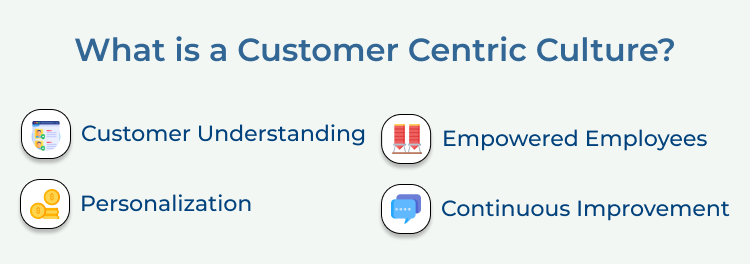
Key components of a customer experience culture:
When brands are customer-focused, all the policies and operations are set around customers in a bid to give them the experience of a lifetime. Having such a culture means always striving to provide the best customer experience both at the point of selling and post-selling to gain a competitive advantage.
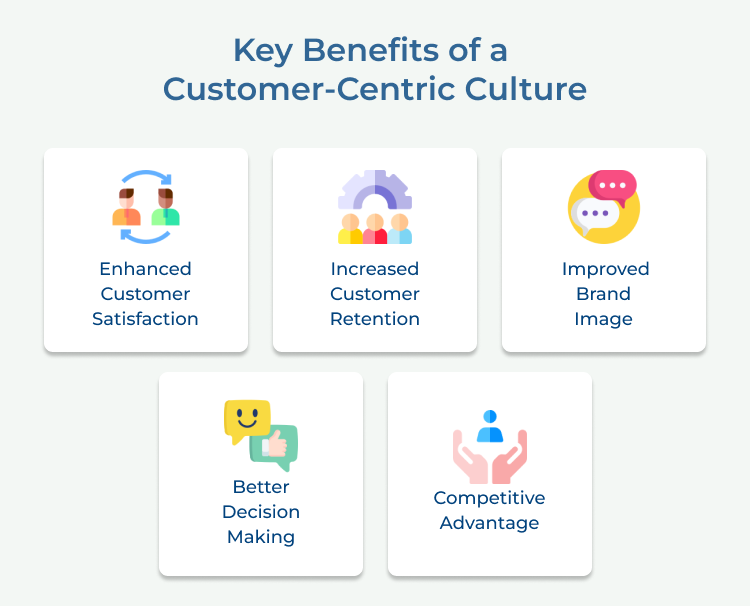
Here are the important reasons why a customer experience culture is beneficial for businesses:
Keep customers at the center of your business operations to improve customer satisfaction. When customers feel their needs are met, they are more likely to develop loyalty towards your brand. Happy customers become brand advocates and recommend your products to others.
Customer-centric culture emphasizes building long-term client relationships by consistently delivering value. Understanding their needs and providing personalized experiences can reduce the churn rate. Satisfied customers are likely to stay with your brand for a long time.
Customers are more likely to view your brand positively when they genuinely care about needs. A positive rapport can attract new customers and differentiate your business from competitors. It also helps in building trust, which is essential for customer retention and repeat business.
A client-centric culture encourages data-driven decision-making. Understanding what customers want allows you to tailor your products/services/marketing efforts to meet their expectations. A targeted approach leads to better results and reduces the risk of wasting resources
A customer experience culture helps businesses stand out from the competition. Consistently delivering exceptional customer experiences will differentiate you from competitors. Putting customers first can become a unique selling point that sets you apart in the market.
A customer-centric culture is not just delivering great products, it is about understanding the needs of your customers in every interaction. A study by Forrester found that businesses with a strong customer experience focus outperform their competitors by 80% in terms of revenue growth.
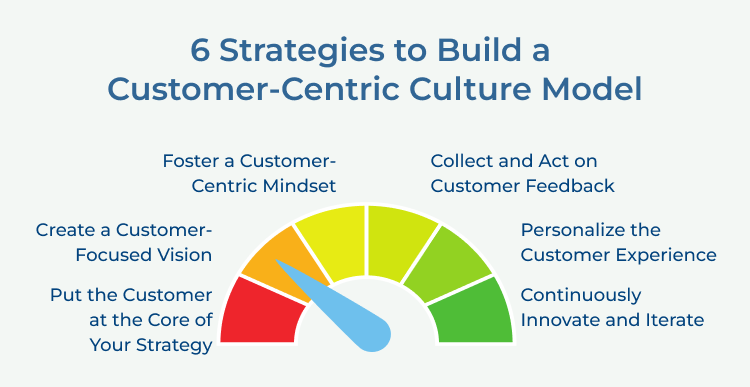
Here are six points to consider when building a client-centric mindset within your organization:
Shift your mindset and place the customer at the core of your business strategy. Make customer satisfaction the driving force behind all decisions. Invest time to understand your customers’ needs and align your business objectives accordingly.
Prioritizing the customer needs and preferences can help businesses to deliver a personalized experience. A client-centric approach is essential for long-term success in the competitive market.
Best Practices:
Develop a clear vision that emphasizes the importance of customer satisfaction in delivering exceptional CX. Communicate the vision regularly and ensure that it is embedded within the company’s culture. Encourage employees to embrace the customer-centric mindset and empower them to take ownership of customer resolutions.
How does creating a customer-focused vision help your business?
Creating a customer-focused vision provides a clear direction for the organization that aligns all employees toward a common goal. It serves as a guiding principle that emphasizes the importance of customer satisfaction and loyalty for long-term business success.
Best Practices:
Comprehensive training helps employees understand the value of customer-centricity and how it aligns with their roles. Encourage open communication, both internally and externally, to build strong relationships.
Create a supportive work environment that recognizes and rewards employees for exceptional customer service. Prioritizing customer expectations can truly enhance their satisfaction. It involves understanding their preferences and delivering exceptional experiences.
Best Practices:
Collect feedback from your customers through surveys, social media platforms, or direct interactions. Analyze the feedback to identify areas for improvement and make necessary adjustments.
Actively seek feedback from all departments and encourage cross-functional collaboration to address customer pain points effectively. By implementing customer feedback, businesses can build trust, loyalty, and long-term relationships with their customers.
Best Practices:
Customer segmentation, data analytics, and automation tools are used to deliver personalized marketing messages. Make each customer feel valued and special by showing that you understand their unique requirements.
Personalizing the customer experience culture shows that businesses value their customers as individuals, leading to increased customer satisfaction. Personalization fosters a stronger connection between businesses and customers, ultimately driving business success.
Best Practices:
Customer expectations are constantly evolving, so it is essential to stay ahead of the curve. Encourage a culture of innovation and experimentation within your organization. Involve your customers in the product development process by soliciting their ideas and feedback.
To build a customer-centric culture, constantly seek improvement and embrace changes so businesses can deliver a superior customer experience.
Best Practices:
Customer-centricity is a business strategy where businesses put their customer first. All business operations center around the needs of the customers and their positive experience.
Big giants like Starbucks, Amazon, Netflix and Walt Disney World are often cited for their customer centricity, as they should be.
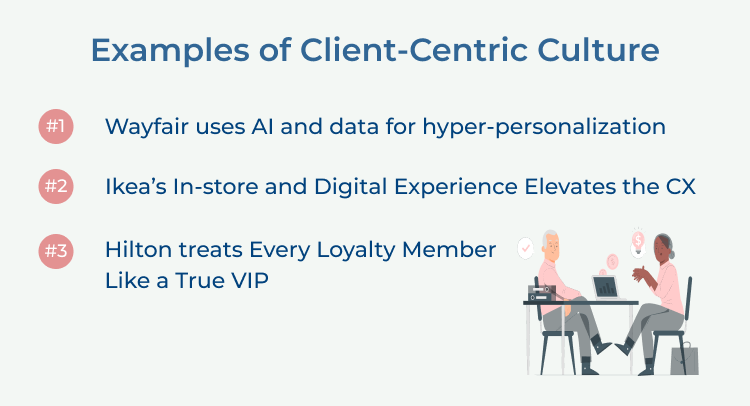
Here are 3 examples of online companies that have successfully embraced a consumer-focused culture:
Wayfair uses predictive analytics and AI to create detailed buyer personas to show the most relevant products for customers, eliminating the need to scroll through pages and pages of products to find something they like. The company offers over eight million products, from furniture and décor to appliances and storage.
The customer centricity at IKEA is to create a better everyday life and is committed to meeting the needs of its customers by creating a great customer experience. It is recognized for its immersive in-store customer experience. Customers shop carefully furnished and curated spaces, visit a food court snack on famous meatballs, and even take advantage of complimentary childcare.
Hilton is one of the biggest hotel brands in the world that has implemented strategies to be truly customer-centric. The driving force behind this is the Hilton Honors guest loyalty program, which has over 115 million members. The free Hilton Honors mobile app allows guests to book their stay, select the exact room they want, order meals, check in/out, and unlock their doors/elevators with a Digital Key, all from their smartphone.
A client-centric culture focuses on putting the customers at the heart of every decision. Implement these best practices to improve customer satisfaction and loyalty.
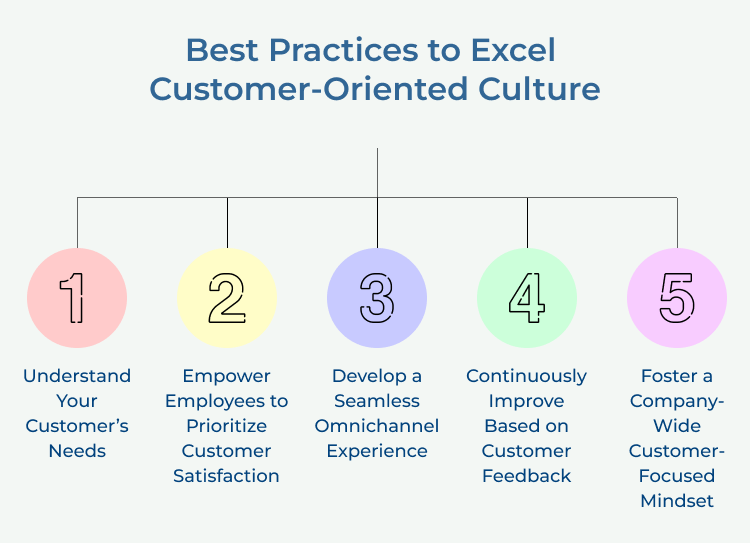
Here are five essential best practices to help foster a consumer-oriented culture within your organization.
Businesses must have a deep understanding of your customers’ needs to cultivate a customer-centric culture. Conduct market research, collect customer feedback, and analyze data to identify trends or patterns. Regularly communicate with customers through surveys and interviews to build strong relationships.
Empower your employees to go above and beyond in meeting customer needs, resolving issues promptly as well as delivering exceptional experiences. Provide comprehensive training programs to enhance customer-centric skills and instill a customer-focused mindset. Reward employees who consistently demonstrate exceptional customer service.
Creating a seamless omnichannel experience is crucial for a customer-centric culture. Ensure that all channels provide a consistent brand experience and maintain open lines of communication. Make it easy for customers to transition seamlessly between channels, ensuring they receive the same level of service and support.
Gathering regular client feedback is essential to understand their evolving needs and identify areas for improvement. Analyze feedback, identify recurring themes and take corrective action when necessary. Regularly communicate with customers about the changes you’ve made based on their feedback to improve customer satisfaction.
Creating a customer-centric culture requires buy-in from every department and level of the organization. Communicate the importance of customer-centricity and embed it in the strategy. Encourage cross-functional collaboration and knowledge sharing to ensure everyone understands.
Embracing a customer-centric culture is essential for the success of any business in a competitive market. By prioritizing the needs of customers, companies can build strong relationships. A customer-centric culture involves understanding customer expectations and analyzing customer feedback. It requires a commitment from every department to put the customer at the center of every decision and action.
Businesses can create loyal customers who will advocate for their brand and contribute to long-term success By cultivating a customer-centric culture.
1. Why is being customer-centric important?
Being customer-centric is crucial for the success of any business. When a company focuses on understanding and meeting the needs of its customers, it can provide better products that truly resonate with them. Customer-centricity also allows for better decision-making as it relies on data-driven insights and feedback from customers.
2. Why does a customer-centric culture matter?
A customer-centric culture is vital for the success of any business. It places the customer at the center of all decision-making processes and actions, prioritizing their needs. A customer-centric culture also enables companies to gain valuable insights into customer behavior, allowing them to tailor their products to meet specific needs. Putting customers at the core creates a foundation for long-term success and growth in today’s highly competitive business environment.
3. What are the stumbling blocks to moving towards a customer-centric culture?
Moving towards a customer-centric culture can be a challenging endeavor for many organizations. One stumbling block is the resistance to change from employees who are comfortable with the existing ways of doing things. lack of clear communication about the importance of customer-centricity can lead to confusion and hesitation among employees. Another stumbling block is the tendency to prioritize short-term profits and immediate gratification over long-term customer satisfaction.